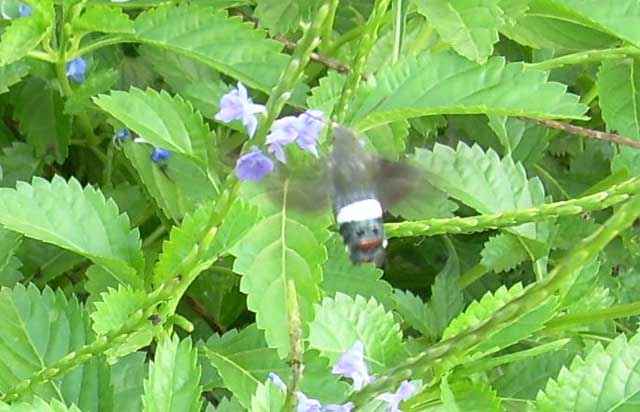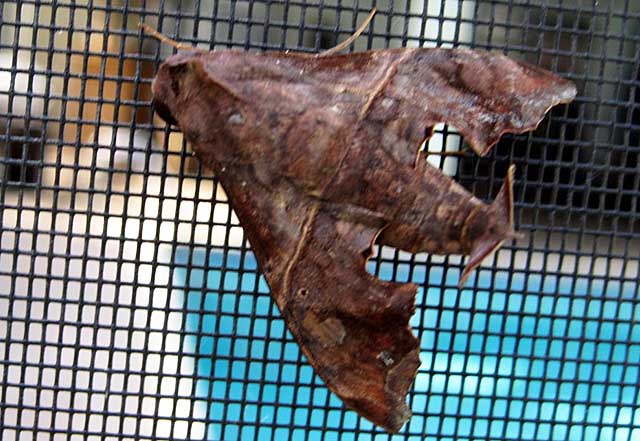Sphinginae subfamily
Sphingini tribe:
 |
This species is a strong migrant and adults nectar from
deep-throated flowers including moonflower (Calonyction aculeatum),
morning glory (Convolvulus), honey suckle (Lonicera)
and petunia (Petunia species).
|
 |
The upperside of the forewing is yellowish brown with no white markings, but there are indistinct black lines and dashes.
The cell spot is gray with a black outline. The larvae feed in large groups and are much more
spectacular than the moths.
Catalpa is the larval host.
|
 |
The upperside of the forewing is pale brownish gray with wavy black and white lines and a black-outlined white cell spot.
The upperside of the hindwing is gray with diffuse darker bands.
|
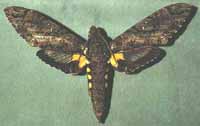
|
The upperside of the forewing is a blurry yellowish gray. The
upperside of the hindwing is dark gray with yellow at the base and a
dark "tooth" projecting from the margin into the translucent area
between each vein.
|
 |
The upperside of the forewing is dark brown with a dusting of white
scales. Some moths have patches of reddish or yellowish brown on the
wings.
|
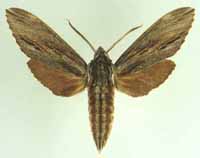 |
Isoparce cupressi
WO, the Cypress or Baldcypress Sphinx
Isoparce cupressi, the rare Cypress Sphinx, flies in Cypress swamps in Georgia (specimen type locality), and from Maryland to Texas.
It has been reported in Mexico.
|
 |
The upperside is of the forewing is gray with two
(sometimes one or three) black dashes near the wing center; other
markings are usually diffuse. The upperside of the hindwing is a uniform brown-gray.
If you've got pines, this species is likely present.
|
 |
The upperside of forewing is gray to grayish brown with a black line
running from the middle of the costa to the middle of the outer
margin; the line may be broken near the margin. There is a splash of
brown around the cell spot.
|
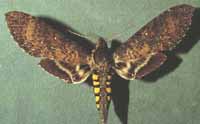 |
Manduca occulta
WO, the Occult Sphinx
Manduca occulta can be differentiated from M. sexta which has 2/3 black, 1/3 white checkering on the forewing,
while occulta has equal amounts of black and white checkering.
(very unlikely; rare stray)
|
 |
If you grow tomatoes, you might encounter
Manduca quinquemaculata.
|
 |
Look for three large yellow spots
on each side of the abdomen. The upperside of the forewing is
yellowish brown to deep chocolate brown with a dusting of white
scales and zigzagged black and white lines.
|
 |
Manduca sexta
BAMONA, the Carolina Sphinx
If you grow tomatoes, you have probably encountered Manduca sexta
in the larval stage.
Larvae get very large and can strip a tomato plant.
|
 | The upperside of the forewing is gray with indistinct black and
white markings. There is a series of black dashes
from the base to the tip, and a small white cell spot.
|
 |
Sphinx gordius
Okeechobee, the
Apple Sphinx
The upperside of the forewing ranges from brown with black borders
through brownish gray with paler borders to pale gray with no
borders. probably uncommon; less likely south of Okeechobee |
Smerinthini Tribe:
 |
Named for the small eye-spot in the hindwing, this moth has a wide
distribution and is probably present in Broward County.
I regularly see them on Prince Edward Island, and they are reported
as far south as southern Florida.
|
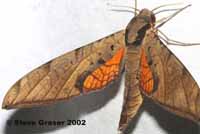 |
The inner margin of the forewing is indented. The upperside of the
forewing is pale yellowish gray in the pale form and reddish brown in
the dark form. A dark submarginal line runs from the apex to the
anal angle.
|
Macroglossinae subfamily
Dilophonotini tribe:
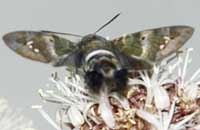 |
The body is reddish brown with a wide white band across the abdomen.
The forewing upperside is reddish brown with a black cell spot and 3
white spots near the gray marginal area. A pale streak runs from
the cell spot to the inner margin of the wing.
|
Aellopos tantalus hovering on porter weed, Lovers Key State Park, August 17, 2010, Catherine C. Bowron.
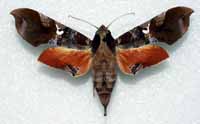 |
This species is reddish, has falcate wings
and flies after midnight. It might be in Monroe County as a stray.
|
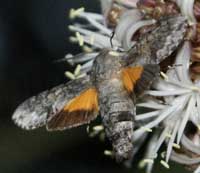 |
Cautethia grotei
BAMONA,
the Grote's Sphinx:
The upperside of the forewing is pale silvery gray with black markings; in some moths the wing base may be very dark.
The upperside of the hindwing is deep yellow-orange with a black border that covers less than half the wing.
This species is rarely recorded in the U.S., but there are sightings
from Florida, South Carolina, New Jersey, New York,
Massachusetts and
New Hampshire.
|
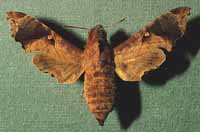
|
Enyo lugubris, the Mournful Sphinx,
BAMONA/EZ/Hendry
The body and wings are dark brown. The forewing has a large black
patch covering most of the outer half of the wing. There is a pale
tan cell spot (dark inner pupil), and a fairly straight median line
to the inside of the cell spot.
|
Enyo lugubris, the Mournful Sphinx, Cape Coral, Lee County, December 3, 2018, Eric Zulkowsky
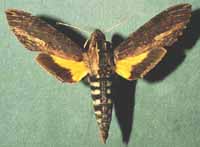 |
Erinnyis alope
BAMONA/Okeechobee, the Alope Sphinx
The upperside of the forewing is dark brown with short yellowish
streaks on the forward half and wavy yellowish bands on the rear
half.
|
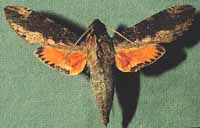 |
The upperside of the abdomen is gray, without black bands, and
the underside does not have black spots. The upperside of the
forewing is dark brown, and may have pale yellow-brown patches
along the inner edge.
|
 |
The abdomen has very distinct gray and black bands. The female's
forewing upperside is pale gray with a few dark dots near the outer
margin.
|
 |
During the night adults nectar at flowers, including bouncing bet
(Saponaria officinalis) and Asystasia gangetica beginning at dusk.
July and August are flight times in the southern states.
|
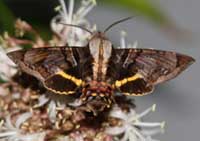 |
The wide brown band down the center of the creamy-grey thorax and uppe rhalf of the abdomen, as well as the bright hindwing yellow band
clearly distinguish this species.
|
See Hemaris comparison to help distinguish
the next three species.
 |
Hemaris thysbe
BAMONA, the Hummingbird Clearwing
It is not difficult to see why many gardeners would mistake an
Hemaris thysbe moth for a small hummingbird as it hovers,
sipping nectar from flowers through a long feeding tube.
|
 |
Hemaris diffinisBAMONA, the
Snowberry Clearwing or Bumblebee Moth
Adults mimic bumblebees and are quite variable. The wings are basically clear, with dark brown to
brownish-orange veins, bases and edges. The thorax is golden-brown to
dark greenish-brown. The abdomen tends to be dark (black) with 1-2
yellow segments before the tip. unlikely
|
 |
Hemaris gracilis
WO, the
Slender Clearwing or Graceful Clearwing
This day-flying moth is less common and has not been recorded in
Lee County, but it may be present. generally more northerly
|
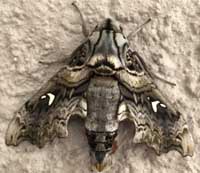 |
Madoryx pseudothyreus floridensis, the Floridian False-windowed Sphinx,
BAMONA
The wing margins are scalloped. The upperside of the forewing is
brown with dark brown and tan markings. The forewing has a V-shaped
white spot near the center of the costa.
Nominate pseudothyreus is probably limited to Cuba, and Madoryx pseudothyreus bahamensis replaces
pseudothyreus in the Bahamas.
|
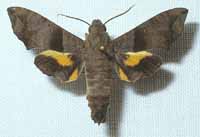 |
Perigonia lusca,
the Half-blind Sphinx or Coffee Sphinx,
WO
The wings and body are dark brown. The upperside of the forewing has
darker median and submedian bands, and gray along the outer margin.
|
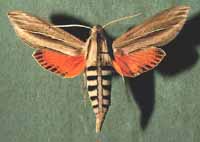 |
The abdomen of the Caicus sphinx has distinct black and tan bands.
The upperside of the forewing is brown with a tan band along the
inner margin and a thin tan streak in the middle of the wing.
|
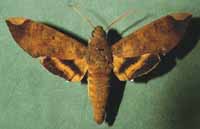 |
Pachylia ficus, the Fig Sphinx,
BAMONA
The upperside of the forewing is orangish brown
with a paler patch along the costa at the tip.
The upperside of
the hindwing is orange to orangish brown with a black outer border, a
black median band, and a white spot on the outer margin near the body.
|
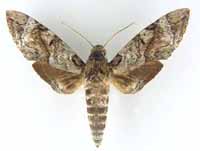 |
The upperside of the forewing is dark brown with a dark spot at the
base of the costa and blurry gray and white markings. The upperside
of the hindwing is dark brown with white along the inner margin, and
the lower half of the outer margin. big, colourful larva
|
Philampelini tribe:
 |
Larvae get large and feed on grape vines and Virginia creeper.
Note the differences between this moth and the Pandorus Sphinx.
|
 |
Eumorpha fasciatus
BAMONA/Hendry, the Banded Sphinx
The upperside of the moth is dark pinkish brown. Each forewing has a
lighter brown band along the costa, and sharp pinkish white bands and
streaks. Larvae feed upon primrose-willow, Ludwigia (water primrose)
and other plants in the evening primrose family.
|
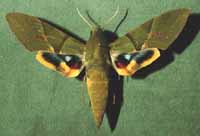 |
The Gaudy Sphinx flies in America, and although primarily a tropical
species, it has been taken as far north as Saskatchewan as a stray.
Forewings are a vibrant grey-green.
|
 |
If you have Grape or Virginia Creeper nearby, then you probably have
this species.
I often get asked to identify larvae from areas not
previously reported.
|
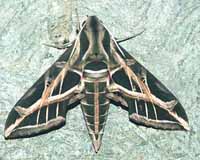 |
The upperside of the moth is dark pinkish brown. Each forewing has a
lighter brown band along the costa, and sharp pinkish white bands
and streaks.
Note positioning of lowest thin forewing white line
(inside the thick center lines)
as compared to E. fasciatus.
|
Macroglossini tribe:
 |
Amphion floridensis
WO/Okeechobee,
the Nessus Sphinix:
This day flier is widely distributed. If you have Virginia Creeper, you
probably have the Nessus Sphinx. Two bright, distinct, narrow yellow
bands are often visible on the abdomen.
Also note
two small yellow patches in each concave region of the forewing fringe.
|
 |
Darapsa myron
WO, the Virginia Creeper Sphinx or the
Grapevine Sphinx
If you have the
foodplants indicated in the common names, you probably have this
species nearby. The lower wings are orange.
|
 |
If you have hydrangea growing near a stream, then you might have the
Hydrangea Sphinx.
|
 |
Hyles lineata
BAMONA, the White-lined Sphinx
The forewing upperside is dark olive brown with paler brown along the
costa and outer margin, a narrow tan band running from the wing tip
to the base, and white streaks along the veins.
|
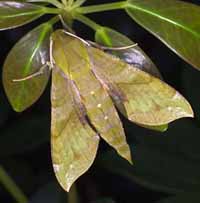 |
The upperside of the forewing is olive green with a paler median band
and pale lines with purple shading along them. The upperside of the
hindwing has a white spot surrounded by black at the base, a wide
orangish yellow median band, and a brown to greenish band along the
outer margin.
The head and flared thorax of larva suggest the appearance of a snake.
|
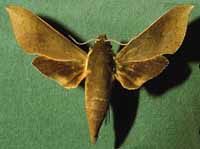 |
The upperside of the forewing is olive-brown with lighter brown along
the outer margin. The upperside of the hindwing is brown with some
paler spots.
|
 |
Xylophanes tersa BAMONA/DC/Hendry/Okeechobee,
the Tersa Sphinx
The upperside of the forewing is pale brown with lavender-gray at the base and
has dark brown lengthwise lines throughout.
This moth is a strong migrant.
|
Xylophanes tersa, south of Fort Myers, Feb. 22, 2012, David Cox
|
|
